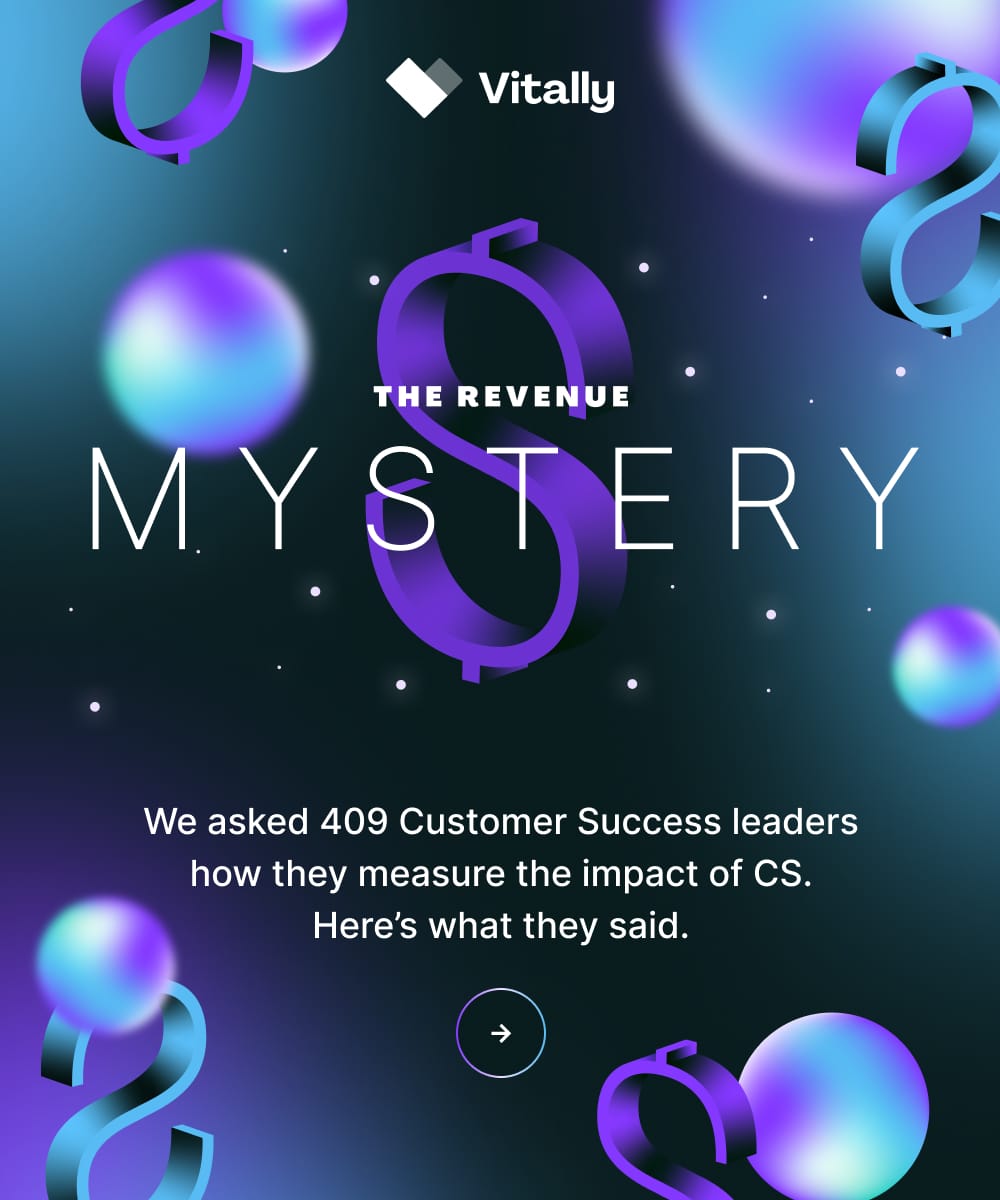
If you work in the B2B industry, you’ve likely heard of the dark funnel.
“The dark funnel” describes the ever-ambiguous “channel” that draws unattributable, quality sales leads to an organization.
These leads often show up unannounced; they weren’t a content lead, then a webinar attendee, and then a demo form-fill like a traditional B2B SaaS inbound lead might be. They got to know your company by some untrackable means — maybe by listening to a podcast episode with one of your executives or reading about a service you offer in a Slack community they’re a part of — and now they’re a legitimate prospect.
They lurk, then convert.
Of course, Sales organizations big and small welcome these mystery leads, which got us thinking: Is there a dark funnel equivalent on the post-sales side? In other words, are there unknown pathways or hidden-in-plain-sight revenue signals Customer Success professionals are missing that would lead to more reliable expansion opportunities?
We turned to three post-sales experts from our Success Network to weigh in on this:
- Mark Stagi, VP of CS at Avoma
- Lauren Axworthy, Founding Account Manager at Vitally
- Emory Scott, Senior Success Manager at POSH
Here’s what they said.
The Consensus: There’s Not Exactly a Post-Sales “Dark Funnel”
Mark, Lauren, and Emory are all on the same page here: There’s not a clear “dark funnel of expansion” filled with unexpected, unattributable revenue opportunities that CSMs and AMs are missing. Sure, sometimes expansion deals come out of the woodwork by surprise — and that’s always a treat — but more often than not, expansion opportunities don’t create themselves. They’re hidden until a proactive post-sales professional uncovers them.
Mark says it well: “There are some hidden areas of revenue, for sure. But most of those ‘hidden opportunities’ are attributed to us not thinking and measuring what we need to think about and measure… We need to turn over every rock within each of our accounts.”
He went on to say that the most curious post-sales professionals, the ones who do ample research on each of their accounts and ask good questions, can almost always find an expansion opportunity — that’s not the hard part. The hard part is running an expansion deal with a process that’s as focused, thoughtful, and methodical as a pre-sales opportunity, which brings us to the second consensus…
The Second Consensus: Expansion Opportunities Are Overlooked
So we’ve established that there’s not a “dark funnel of expansion” per se, at least not one that’s similar to the dark funnel that pre-sales marketers, BDRs, or AEs pay attention to. Instead, there are just missed revenue opportunities on the post-sales side due to a lack of strategy. Luckily, it’s possible to right the ship.
At a macro-level, here’s what Emory from POSH thinks more teams should do:
“The best way to find hidden revenue opportunities is by:
- Having in-depth user conversations,
- Utilizing unbiased consumer discovery to overturn key findings, and
- Identifying pain points.”
Lauren from Vitally agrees: “I've found that most post-sales revenue comes from just having my boots on the ground: joining calls, understanding growth initiatives, and learning about changes within each account’s team structure that we may have solutions for.” She uses (and sells!) Vitally to understand what past behaviors have led other Vitally customers to spend more. To give you a glimpse behind the curtain, if a Vitally customer is piping in more data by using more and more integrations or attending our events consistently, they’re indicating they’re ripe for expansion, and Lauren always reaches out to them.
Mark and his team at Avoma sell their software by seats and work to “land and expand” business by selling more seats within existing accounts. To do this, he encourages his teammates to consider “what the whole account looks like; not just what the specific team that bought Avoma looks like, but what their Customer Success org looks like, what their Recruiting team looks like.” These teams likely have different budgets, different stakeholders, and different needs. To neglect them (or not ever ask about them) is to leave money on the table.
To avoid leaving ever leaving money on the table, our three experts shared these five expansion tactics:
5 Tactics for Uncovering Expansion Opportunities
#1. Stay Curious and Proactive 💡
This tactic sounds generic on the surface, but in practice, it’s valuable. It’s easy to get into a cycle of routine, maintenance-based customer care. Instead, dig deep as you work to learn more about industries represented within your customer base and individual customers themselves.
Emory Scott reflected on a former employer of his that incentivized this kind of curiosity:
“I used to work for a fantastic startup out of Austin, Texas, called Interplay Learning, which provided VR training for the skilled trades industry. The CEO regularly offered to pay for our lunch if we went for sandwiches at the Subway down the street and conversed with the HVAC and skilled trades industry veterans that frequented it. These unknown pain points and expansion opportunities can best be found through in-depth, empirical conversations."
In addition to learning about broader industries, ask your customers detailed, focused questions regularly about the direction of their company, high-level goals, upcoming initiatives, and their general opinions on what’s happening within their organization. Then, actively listen to their answers because your next big expansion lead might just come from those conversations.
#2. Remember That Timing Is Everything ⏰
As with pre-sales deals, timing is everything in post-sales expansion. This point goes hand-in-hand with #1 because if you’re curious and learning about the market you sell in and individual accounts, you’ll know how to strike while the iron’s hot.
According to Mark Stagi, a prime example of “good timing” for expansion conversations is after a customer raises a new series of funding. Pay attention to when any of your customers announce a round of funding, and remember that it doesn’t automatically mean there’s more money headed your way. In fact, often after new funding, companies look to make big moves and revamp their tech stack.
If you don’t send your congratulations and start commercial conversations early, you risk losing an account altogether (ex. A HubSpot customer might switch to Salesforce simply because they’ve heard it’s better for bigger companies, and they now have the means to pay for it). Full-fledged churn like that would be the worst case, but you also risk settling for a smaller expansion or upgrade rather than a massive, whale deal (ex. A HubSpot customer might only ask to add a few new seats to their Sales organization unless you explain why now’s the best time for the entire go-to-market organization to have a seat within the platform).
#3. Study Each Account’s TAM Monthly 📅
In the same way most pre-sales teams review net-new pipeline on a weekly or bi-weekly basis, consider doing the same with what Mark dubbed the TAM (total addressable market) within your accounts. In other words, look at what other teams or departments across each customer could use your services, and make thoughtful plans to reach out to them (more on this in #4).
If you’re wondering how to accurately understand and track how many people would fall into the TAM of an account, here’s what Mark suggests:
- Be as smart as your customer. Using LinkedIn Navigator (or a similar tool), look at the breakdown of your account by employee type. Look at recent press releases. Look at their careers page to spot growing teams. If they’re a public company, look at annual reports, hiring plans, and other public data. Then, validate all of this with your customer.
- Ask for introductions. Don’t be afraid to ask for introductions and intel if you have a well-established, stable relationship with a customer. Often they’re happy to help other departments if they see a clear problem that your product or service can solve.
#4. Bring Your A-Game, Always 🏆
It’s a slippery slope to assume that just because a customer has been with you for a while, they’ll stay and grow with you over time. If they’re shopping around, they’re getting a polished, process-driven pre-sales experience, complete with relationship building, potential discounts, trials, dedicated Account Executive attention, and more. If your pitch as the existing solution is a slide deck and talk track that goes, “So, here’s the latest package upgrade option, and here’s the price,” you aren’t doing yourself any favors.
Assume your customers are always considering your competitors, especially after they do major launches or announce M&A deals. Bring standardization, process, and excellence to those customer expansion calls and rise above the more informal or informational status quo for retention and expansion.
#5. Consider Charging More 💸
Last but not least, a great way to increase expansion revenue is to boost your rates or charge for above-and-beyond product requests. This is, of course, an executive-level decision you’d need to bring to the table and gain agreement on, but it’s worth the conversation.
“Everything is inflated right now,” Lauren from Vitally told us, “so naturally, your services should increase in cost as well. If you’re continuing to invest in new functionality in your platform, and you’ve put a lot of work into it, then there should be incremental costs year-over-year.”
Some B2B organizations are even starting to charge for custom or sped-up product development in the same way they’ve charged for add-ons and services for years. In Lauren’s experience, most customers understand these incremental increases and extra expenses — and most even expect them. Don’t hold your rates without a good reason to.
Closing Thought: Expansion Requires Immense Thoughtfulness
Improving the Customer Lifetime Value (CLTV) for as many customers as possible isn’t a mystery in the same way the pre-sales dark funnel is. It’s much more methodical and systematic.
According to our experts, the most reliable way to see expansion success is by hiring excellent, well-rounded Customer Success professionals — “the ones who know how to sell, how to build relationships, and how the product works” as Mark says — and leaning on powerful CS software to spot opportunities — “a tool like Vitally helps CS pros understand each customer’s pain and communicate the cost savings of added investment.”
Want to make it a little lot easier to secure expansion revenue? Take a tour of the Vitally platform or schedule time with our team to learn more.










